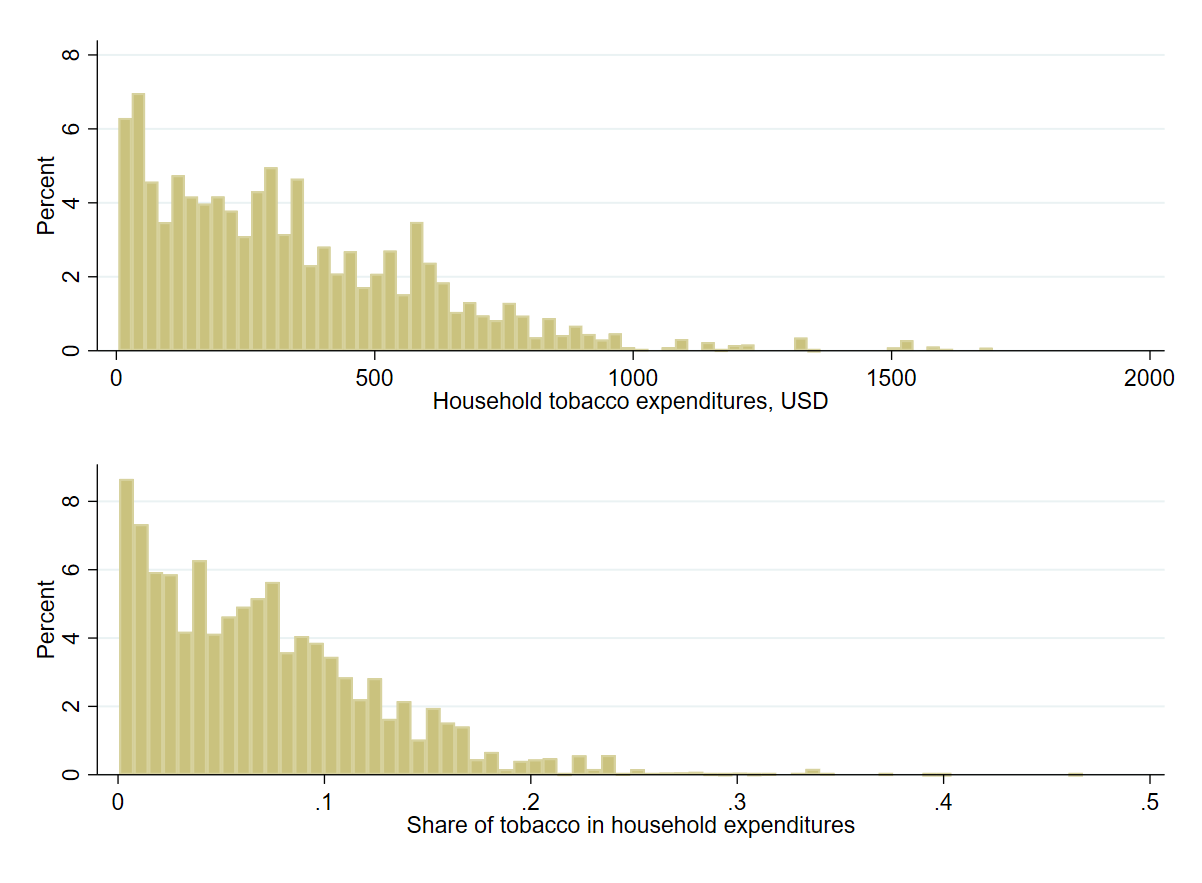Tobacco use remains a major public health concern leading to 18% of all deaths in Ukraine. The evidence from a 2021 household survey shows that 29% of households have positive tobacco expenditures with the average spending of $340 per year in families with smokers. Moreover, the share of families not having enough money for food would double if every family in Ukraine used tobacco. The situation has likely worsened after the start of the full-scale war.
What do we know about the burden of tobacco use in Ukraine?
Tobacco use remains a major public health concern in Ukraine. In 2019 smoking prevalence in Ukraine among people aged 15+ was estimated at 42.0% for men and 14.4% for women resulting in 18% of all deaths in Ukraine being caused by tobacco use (28.4% among men and 6.9% among women). Reitsma et al (2021) also report that Ukraine has the highest death rate from smoking among males in the world – 487 per 100 000 males (with 95% uncertainty interval of 396–590).
In addition to enormous social and health burden this deadly habit also generates astonishing economic losses. The World Health Organization estimates the annual cost of USD 1.4 trillion in health expenditures and lost productivity due to tobacco use worldwide. In addition, smoking tobacco brings along a significant socio-economic burden that falls disproportionately on the most vulnerable populations, thus exacerbating poverty. Poor households, spending a larger proportion of their income on tobacco, have to sacrifice basic necessities such as food, education and health care. WHO also reports that tobacco use leads to cancers, heart attacks, respiratory and other diseases imposing additional health care costs.
Previous literature shows that tobacco expenditures negatively affect the share of family spending on foods, education and medical care (Wang, Sindelar and Busch 2006). In the context of Ukraine, Serhieieva (2021) showed that smoking was associated with decreased expenditures on food and beverages along with healthcare expenses.
This article provides evidence from a recent working paper (Obrizan 2024) on the effects of tobacco use on poverty and deprivation in Ukraine in 2021 – the last year before the full-scale Russian invasion.
Tobacco prevalence and expenditures in Ukraine in 2021
This article uses the “Household living conditions survey” for 2021 collected by the State Statistics Service of Ukraine (UkrStat). According to UkrStat, the purpose of the survey is to obtain data on the socio-demographic characteristics of households, the structure of their expenditures and resources, as well as for a comprehensive study of the material well-being of various social groups of the population.
The 2021 survey includes 2 datasets: 7,614 households and 15,824 individuals that can be merged using family identifiers. The data about tobacco and other expenditures as well as indicators of poverty and deprivation (such as having difficulty with paying for basic food, healthcare and education) are available at the household level only. Hence, the unit of analysis is a household – up to 7,578 households (or 99.5% of the original sample) are used in models after removing observations with missing data.
Table 1 presents key descriptive statistics regarding household tobacco expenditures in Ukraine in 2021. On average, 29% of households have positive tobacco expenditures. The mean household expenditure on tobacco is $98.49 per year if one includes even households with zero tobacco spending. This comes to about $1.4 billion per year of total spending on tobacco, which is about 25.6% of the estimated total economic cost of smoking including both direct healthcare expenditures and indirect costs related to lost productivity due to illness and premature death (as reported by the Tobacco Atlas). The average tobacco spending is much higher ($339.63) among households with positive tobacco expenditures. Maximum annual tobacco expenditure reaches $1695.86, indicating significant variation among households. The share of tobacco in cash expenditures is on average 2.1% but the maximum share can reach 46.8% of total cash expenditures of a household. 7.4% of households spend 10% or more of their cash on tobacco.
Figure 1 shows histograms of household tobacco expenditures and shares of tobacco expenditures for households with smokers. Both distributions are skewed to the right with the majority of households with smokers spending less than $500 and less than 10% of family cash expenditures. However, the shares of households with higher tobacco expenditures (in USD and relative to total expenditures) are also considerable. These numbers indicate that purchases of tobacco products can be a substantial financial burden on households with smokers.
Figure 1. Distribution of households with positive tobacco expenditures by the sum of tobacco expenditures per year
Note: Author’s calculations based on 2021 “Household living conditions survey” using household weights.
Which households spent more on tobacco in 2021?
It is of interest to determine which household characteristics are associated with higher tobacco expenditures. Although such models don’t necessarily have causal interpretation, they still represent important information about correlates of tobacco use. Models use robust standard errors with household weights and clustering at the region (oblast) level.
The survey allows to include many socio-demographic and socio-economic characteristics into regression models. In particular, models include the following socio-demographic measures: 5 indicators for age and gender of the household head (18-29 years old, 30-59 years old and 60+ years old for both genders with female heads of 18-29 years old being the base category), household size, number of children under 18 and persons of 56-59 and 60+ years old and the number of retirees (with the understanding that retirement and age capture different aspects of individual dynamics).
Socio-economic characteristics include: two indicators for city size (less than and more than 100 thousand inhabitants with countryside being a base category), educational indicators for household members: higher education and no primary education (with the middle category of high school or similar education being the base category), number of rooms in the dwelling, indicators for the absence of running water, indoor toilet and hot water in the dwelling and indicators for households having a land plot and a livestock.
Table A1 in the Appendix provides the estimation results. Quite logically, the probability of positive household tobacco expenditures increases by 11.3 percentage points and by $46.59 for each additional household member (hereafter coefficients are significant at 1% unless noted otherwise). Results also indicate that respondents living in big cities (with population more than 100 thousand) have 8.3 p.p. higher probability of having positive tobacco expenses and $33.42 more in annual tobacco spending (both coefficients are marginally significant at 5%).
On the other hand, lower tobacco use is associated with each additional child under 18 years old (by 12.9 p.p. lower probability of positive tobacco spending and $59.35 less in tobacco expenses per year), having any entrepreneur in a household (by 9.3 p.p. and $50.83; significant at 5%), having any person with higher education in a household (by 6.6 p.p. and $25.68).
Was tobacco use associated with poverty and deprivation in Ukraine in 2021?
Linear regression could be a simple way to estimate a potential non-causal association between household i positive spending on tobacco and deprivation (i.e. lack of money to buy food):
Deprivation outcome(i) = a0 + a1*HH with tobacco expenditures(i) + a2*x2(i) + … + e(i),
where a0 represents constant, coefficients a1, a2 etc. show the marginal linear effect of a corresponding factor and e(i) is the household-specific residual not explained by the model.
However, families with smokers may be different in terms of age, income, education making selection into smoking non-random. Instead of linear regression this study relies on propensity score matching (PSM) as a more adequate approach to handle non-random selection into smoking.
In particular, a logit model is used to predict the propensity of having positive tobacco spending in a household based on observed characteristics such as age and gender of the household head, household size etc. Each household with smokers is then matched to a household without smokers (and vice versa) based on the smallest distance between their propensity to smoke (or not to smoke).
A household without smokers has observed (factual) value for a variable of interest (such as the amount of spending on food in UAH). Using the observed spending on food for a matched household with smokers one can obtain a “potential outcome” that a household without smokers would have if they decide to start smoking. When applying PSM, one is often interested in the average treatment effect which is computed by taking the average of the difference between the observed and potential outcomes for each subject.
UkrStat survey for 2021 contains 34 different indicators of deprivation. For example, the first indicator ozn_depr_1 takes value of 1 if a household “has difficulty providing themselves with even the most essential, inexpensive food products” and 0 otherwise. Some indicators of deprivation are not necessarily related to poverty, for example, lack of emergency medical care, which can rather indicate remote location.
For the purposes of this study five key indicators similar to those identified in the previous literature related to food, healthcare and education have been selected for analysis. Table 2 provides shares of deprived households in the sample and average treatment effects (ATE) for the selected indicators of deprivation based on the PSM method that includes the full list of socio-demographic and socio-economic characteristics identified above.
As it is often the case in empirical investigation, preliminary results are mixed. Table 2 shows that only one ATE is statistically significant at 1%, and one additional ATE is significant at 10%, both related to food affordability. In particular, if every family used tobacco, the likelihood of not having enough money for basic food needs would increase by about 5.9 percentage points. This is a huge increase given that only 6.0% of households suffered from a lack of basic food in the 2021 survey!
When interpreting these results one should also remember that the situation with poverty in Ukraine has worsened substantially after the start of the full-scale Russian aggression. Obrizan (2022) showed that in regions with fighting on the ground females without a higher education face a 9.6-9.9 percentage points higher risk of not having enough money for food.
Hence, comprehensive tobacco control measures should be implemented (Shymanskyi 2023), especially in the light of the detrimental effect of smoking on food security, which worsened after the start of the full-scale war.
Conclusions
Tobacco smoking remains a serious public health and socio-economic problem in Ukraine. This study uses the 2021 household budget survey for Ukraine to identify correlates of households that have positive spending on tobacco indicating a substantial socio-economic and socio-demographic variation in this deadly habit.
The effects of smoking on poverty and deprivation in Ukraine are mixed – smoking is associated with increases in deprivation for food but not healthcare and education, perhaps because these are provided by the state (at least to some extent). However, it is possible that the full-scale war could have worsened the situation, which should become the topic of future research when the data becomes available.
References
Obrizan, M., 2022. Poverty, Unemployment and Displacement in Ukraine: three months into the war. arXiv preprint arXiv:2211.05628.
Obrizan, M., 2024. Does tobacco use make Ukrainians poor? Evidence from 2021 household survey. Working paper.
Reitsma, M.B., Kendrick, P.J., Ababneh, E., Abbafati, C., Abbasi-Kangevari, M., Abdoli, A., Abedi, A., Abhilash, E.S., Abila, D.B., Aboyans, V. and Abu-Rmeileh, N.M., 2021. Spatial, temporal, and demographic patterns in prevalence of smoking tobacco use and attributable disease burden in 204 countries and territories, 1990–2019: a systematic analysis from the Global Burden of Disease Study 2019. The Lancet, 397(10292), pp.2337-2360.
Serhieieva, O., 2021. Tobacco use and household expenditures on food, education, and healthcare in Ukraine. MA Thesis, Kyiv School of Economics.
Shymanskyi, V., 2023. The drivers of smoking in Ukraine: the impact of social interactions, alcohol expenditures, and Covid-19. MA Thesis, Kyiv School of Economics.
Wang, H., Sindelar, J.L. and Busch, S.H., 2006. The impact of tobacco expenditure on household consumption patterns in rural China. Social science & medicine, 62(6), pp.1414-1426.
Disclaimer
This research was financed with a fellowship grant from The Virtual Ukraine Institute for Advanced Study (VUIAS). VUIAS didn’t have involvement in the research design, collection, analysis, or interpretation of data, or in the writing of the report.
The author does not work for, consult, own shares in or receive funding from any company or organization that would benefit from this article, and have no relevant affiliations.
I would like to thank the participants of the online research seminar organized at The Virtual Ukraine Institute for Advanced Study (VUIAS), especially Viktoriya Sereda and Daniel Schönpflug, for useful suggestions.
Attention
The author doesn`t work for, consult to, own shares in or receive funding from any company or organization that would benefit from this article, and have no relevant affiliations






